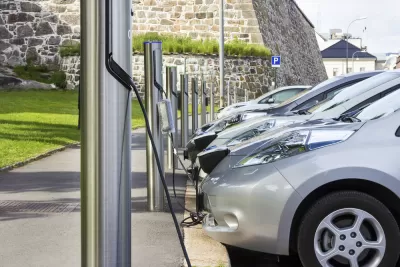With the pandemic and Russia's invasion of Ukraine upending supply chains, the cost of raw materials needed to produce electric car batteries is soaring.

Hyunjoo Jin reports on the shortages facing the electric car industry, particularly as Russia's invasion of Ukraine threatens crucial material supplies. "Rising prices of nickel, lithium and other materials threaten to slow and even temporarily reverse the long-term trend of falling costs of batteries, the most expensive part of EVs, hampering the broader adoption of the technology, said Gregory Miller, an analyst at industry forecaster Benchmark Mineral Intelligence." As Jin writes, "Benchmark Mineral Intelligence said battery producers started increasing lithium-ion cell prices late last year in response to the higher raw material prices they had seen throughout 2021."
According to Jin, "The conflict in Ukraine has only raised the stakes, pushing nickel and aluminium prices to record highs on Monday on growing fears exports from leading producer Russia could be disrupted. Lithium prices also have increased, more than doubling since year end, as supply fell short of rising demand." Coupled with other supply chain issues caused by the COVID-19 pandemic, this could have a significant impact on electric vehicle production and costs.
The article details the cost increases and production delays experienced by various EV manufacturers. Electric truck maker Rivian raised the cost of its vehicles by 20 percent for new orders, while Tesla abandoned plans to build a $25,000 car.
FULL STORY: Analysis: Ukraine invasion sets back Musk's dream for cheaper EVs, for now

Planetizen Federal Action Tracker
A weekly monitor of how Trump’s orders and actions are impacting planners and planning in America.

Chicago’s Ghost Rails
Just beneath the surface of the modern city lie the remnants of its expansive early 20th-century streetcar system.

San Antonio and Austin are Fusing Into one Massive Megaregion
The region spanning the two central Texas cities is growing fast, posing challenges for local infrastructure and water supplies.

Since Zion's Shuttles Went Electric “The Smog is Gone”
Visitors to Zion National Park can enjoy the canyon via the nation’s first fully electric park shuttle system.

Trump Distributing DOT Safety Funds at 1/10 Rate of Biden
Funds for Safe Streets and other transportation safety and equity programs are being held up by administrative reviews and conflicts with the Trump administration’s priorities.

German Cities Subsidize Taxis for Women Amid Wave of Violence
Free or low-cost taxi rides can help women navigate cities more safely, but critics say the programs don't address the root causes of violence against women.
Urban Design for Planners 1: Software Tools
This six-course series explores essential urban design concepts using open source software and equips planners with the tools they need to participate fully in the urban design process.
Planning for Universal Design
Learn the tools for implementing Universal Design in planning regulations.
planning NEXT
Appalachian Highlands Housing Partners
Mpact (founded as Rail~Volution)
City of Camden Redevelopment Agency
City of Astoria
City of Portland
City of Laramie





























